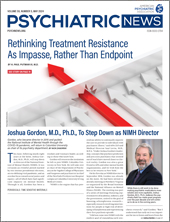Two recently published studies highlight that the mental health impact of climate-related events can manifest quickly.
The
first study, published in
Nature Mental Health, identified an uptick in emergency department (ED) visits for anxiety disorders following wildfire events in the western United States, while the
second study, this one in
JAMA Network Open, demonstrated a connection between large California wildfires and subsequent rises in psychotropic prescriptions. Authors of both studies conveyed that while the physical impacts of wildfires are well known, the psychological ramifications are far less understood and necessitate further investigation.
To explore the connection between wildfire events and anxiety disorders, Yang Liu, Ph.D., chair and Gangarosa Distinguished Professor of Environmental Health at Emory University, and colleagues made use of satellite-driven data. They used maps that provided the locations of wildfires and wildfire smoke in five western states (Arizona, California, Nevada, Oregon, and Utah) between 2007 and 2018. They then compared this geoinformation to nearly 1.9 million emergency department visits for anxiety in these five states during the same period to see if ED visit frequency was related to nearby wildfires or the level of wildfire smoke.
Liu’s team found a small but clear association between ED visits for anxiety and exposure to wildfire smoke. Within 48 hours of a major smoke event (defined as wildfire smoke accounting for at least 75% of fine particulate matter pollution), people were about 6% more likely to visit the ED for an anxiety condition. “We saw quite a strong impact that hasn’t been reported in the literature before,” commented Liu. Liu added that the odds of an anxiety-related ED visit following a smoke event were even higher in women and girls and elderly individuals.
In a related study, Zachary Wettstein, M.D., and Ambarish Vaidyanathan, Ph.D., asked if there was a positive relationship between large wildfires and subsequent psychotropic medication prescribing. Wettstein is a clinical instructor of emergency medicine at the University of Washington School of Medicine in Seattle, and Vaidyanathan is a health scientist with the National Center for Environmental Health at the Centers for Disease Control and Prevention in Atlanta.
Their analysis focused on 25 large California wildfires (those that burned more than 25,000 acres) that occurred in counties with a metropolitan statistical area (an urban center of 50,000+ people) between 2011 and 2018. (As a note, California accounted for 80% of the ED visits in Liu’s study.) Wettstein and Vaidyanathan then used a commercial insurance database to compare psychotropic prescriptions made in fire-affected counties six weeks before and after the start of a wildfire.
The authors found a statistically significant 4%-6% increase in the prescriptions of certain psychotropics in the fire period compared with the pre-fire baseline. Increases were seen for antidepressants, anxiolytics, and mood stabilizers, but not antipsychotics, hypnotics, or statins (which were used as a control medication). Wettstein and Vaidyanathan’s analysis also identified women as having a higher post-fire increase in psychotropic prescriptions compared with men.
The positive relationships established in these studies may have been modest, but they may prove to have a big impact, noted Robin Cooper, M.D., an associate clinical professor of psychiatry at the University of California, San Francisco, and co-founder of the
Climate Psychiatry Alliance. “The findings not only substantiate what is known but add to the fundamental knowledge that can be used to advocate for policy changes,” she said.
Liu is hopeful that effective intervention and prevention measures can be adopted in fire-risk areas. He suggested public information messaging warning about the risks of wildfire smoke and encouraging people to stay inside as a simple, low-cost measure that can be distributed widely. Cooper agreed, adding that “given that climate change-related events like wildfires are anticipated to increase in frequency and severity over time, it’s essential for public health agencies to make very clear how communities can protect themselves.”
Both studies, however, are able to account only for their hard data. Other possible contributing factors, such as socioeconomic determinants of health, were not accounted for in either study. Wettstein and Vaidyanathan wrote, for example, that individuals with limited or no access to mental health services are not included in a commercial insurance database. “Therefore, these findings may vastly underestimate the true risk of mental health effects among those not actively engaged in mental health care, who may be at greater risk without a preexisting structure for support and treatment,” they wrote.
The Nature Mental Health study was supported by a grant from the National Institute of Environmental Health Sciences; the authors of the JAMA Network Open study did not report any financial support. ■

